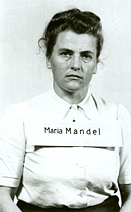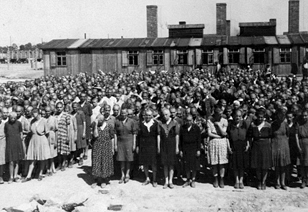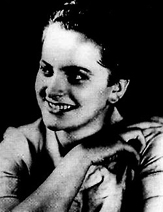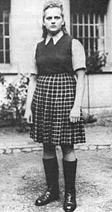SS Female Overseers in Auschwitz
Deported Hungarian Jewish women often encountered SS female overseers in Auschwitz and other camps too. It was no wonder: in January 1945 714,000 inmates were imprisoned in the Nazi camps under the supervision of 41,182 guards. More than a quarter of the prisoners (202,764 people, i.e. 28.4%) and almost one tenth of the guards (3508 people, i.e. 8.5%) were women.[1]
Click here to read more about the Holocaust in Hungary.
During the first six years of the Third Reich's existence, few women were taken to concentration camps.
 |
Rudolf Höss, the commander of Auschwitz |
Out of the 130,000 women deported to Ravensbrück between 1939 and 1945, more than 90,000 died here. Besides hunger and illness, many fell victim to the brutality of the SS female overseers. Many of the SS female overseers trained in Ravensbrück were redeployed to the new concentration camps built after the breakout of the war (Lublin-Majdanek, Auschwitz, Plaszów, etc.).
The women's concentration camp in Auschwitz
The first female prisoners arrived in Auschwitz from Ravensbrück and Slovakia in March
 |
Maria Mandel, the commander of the women's camp |
In the beginning the FKL of Auschwitz operated as an offsite facility of Ravensbrück, its female leader (Johanna Langefeld) was theoretically independent from the male commander of Auschwitz, Rudolf Höss. This command structure resulted in gender rivalry. SS officers openly protested and were not willing to follow the orders of a woman. Höss worried about his power and blamed the new, female colleagues with incompetence: "They were housed extremely well and were paid a salary which they could never have achieved in civil life. They also were not overworked in their duties...Mrs Langefeld was in no way able to handle the situation, but she stubbornly refused any advice from the camp commander [i.e., Höss]... Hardly a day passed in which there weren't discrepancies in the roll call count. In this confusing situation the female guards ran around like excited chickens and did not know what to do." Höss turned to Himmler, but the Reichsführer-SS did not support his ambitions. In spite of that, Höss soon took charge of the women's camp, and as a compromise he developed a parallel, male-female command structure.[4]
Treatment, general circumstance
In October 1942, a 30-year-old Austrian, SS Female Head Supervisor (SS-Oberaufseherin) Marta Mandel
 |
Hungarian Jewish women in Birkenau |
During forced labour and selections, tens of thousands of starving female prisoners tormented by illnesses were treated brutally by Mandel's SS subordinates (report leaders /Rapportführerin/, overseers /Aufseherin/, work unit leaders /Kommandoführerin/) and many times by the prisoner functionaries too (capos, block commanders /Blockältester/, block leaders /"blokovas"/). The general situation is well characterised by the testimonies of some Hungarian Jewish women who survived the Mandel era. The three Hermann sisters arrived in Block 24, Section BIIc of Birkenau from Munkács: "There were 1,000 people in a block. There was no work to do; there were only the continuous roll calls. They normally consumed six hours a day, but if something was not right, for example someone was missing, it lasted even longer, and it could happen that we stayed on our knees till the end. An SS woman gave a blow with a club to Erzsi's head, therefore she had a purulent wound on her head for 8 weeks. She was also operated on in Camp A. Five minutes after she returned from the operation, she had to stand on her knees because of roll call for 5 hours. Nights were terrible because Erzsi's head was purulent and days could pass before they changed her bandage. It badly stank and not only us, who lay at her sides, but also the others lying close to us suffered from it. We asked the Aufseherin to let her stay in during roll call at least when it was raining but she chased her out in the rain with a paper bandage on her head telling her that ‘you would perish here anyhow.' Rain used to fall in the block but that was not the only reason why we could not sleep. The worst thing was that we heard and saw that one arriving transport followed the other. We heard the shouts, the desperate cries for help and the screams."[6]
This is how Mrs Kottmann from Kispest and her daughter characterised the SS female overseers. "These women were also very rude and terrible with us, generally much worse than German men. They would beat us, kick us and shove us for any trifle."[7] The SS female overseers tormented their prisoners not only physically, but also mentally. For example they threatened the women selected for a labour transport that they would be taken into the crematorium.[8]
Mandel and her subordinates
Between 1942 and 1945, at most 170 to 200 SS female overseers performed duties in the Auschwitz complex.
 |
The "beautiful beast" |
Many more remembered SS-Rapportführerin Margot Elisabeth Drechsler (or Drexler, Dreschel). The brutal, evil-minded woman, who appeared as the partner of Dr Mengele, was mentioned as "Drechslerka" by the prisoners following the parlance of the Slovakian Jewish block leaders. I. G. from Keselymező especially dreaded her: "In the block, 14 of us slept on one berth with two blankets. We were often selected; Dr Mengele and Drechslerka did that. We were all very much afraid when they appeared, because we could never know who would be selected for the crematorium".[10] The Hermann-girls had similar memories: "It was very difficult to stay together because Dr Mengele and an SS-woman called Drechsler came every day to do selections. We ran from one block to another, we played hide-and-seek and used all kind of cunning tricks in order to remain together."[11]
The SS-Rapportführerin was an absolute master of life and death: "Once Mrs Drechaler [Dreschler] came, with her huge bloodhound, undressed everybody, took away even our shoes, and we had to stand for hours completely naked, none of us were thinking of life any more, the gas chamber seemed unavoidable." [12]
Irma Grese, "the beautiful beast"
It is an undoubted fact that of all the SS female overseers, the deepest impact in the memories of the Hungarian Jewish women was made by Irma Grese. Grese, also known as the "beautiful beast" and "blond angel," was born in 1923 to a peasant family with five children. She lost her mother at the age of 13. She started to work immediately after finishing elementary school. For two years she worked as an untrained nurse in an SS hospital, then she was an auxiliary worker in a dairy plant. From 1942 she performed telephone duties in the Ravensbrück concentration camp, then she was a guard of a penal company. In the spring of 1943, she was assigned to Auschwitz-Birkenau, where she was the overseer of the road construction work unit (Strassenbaukommando).[13] Soon she was promoted to be one the heads of Camp BIIc, where in the summer of 1944 an average of 20,000 to 30,000 Hungarian Jewish women were lodged under terrible circumstances.
The beauty of the 20-year-old Irma Grese caught the eye of even the deportees: "There was a
Irma Grese
beautiful woman called Grese who rode a bike. Thousands and thousands of people were standing there on their knees in scorching heat, and she took delight in watching us," remembered a survivor from Kalocsa.[14] In accordance with a collective testimony of sixteen young women from Munkács: "Greze used to be an actress, she was a gorgeous, pretty young woman."[15] Jewish physician Olga Lengyel was told by Grese that after the war she wanted to be an actress. She gazed at her reflection in the mirror for hours, and she constantly made her seamstress sew new dresses. She had more than one lover, even prisoners among them. When she got pregnant, she made another Hungarian prisoner, a former doctor, abort her baby.[16]
Grese caught attention not only with her looks, but also her blatant brutality. Each morning a terrible scene was awaiting Ella K. (deported from Paulay Ede Street, Budapest) in the bath barrack: "one of the doors was closed in the back, Grese came in through the other, she beat the unfortunate with a club, everybody tried to get away from her. It was the first time I saw a dead body in the camp, a woman was tread upon. Grese watched it indifferently, with a shrug of the shoulders."[17]
The Ackermann sisters from Ungvár met her at the roll calls, which lasted for hours. "The [18] A housewife from Huszt was taken to Block 16, Camp BIIc: "Our provisions were grass soup that was made of pebbles, pieces of wood and coal. Roll call started already early in the morning and was repeated several times during the day. We were beaten for all possible and impossible reasons. If a woman called Grese came we had to stay on our knees sometimes even for eight hours." [19]
During the dreaded selections Grese generally decided on life and death together with Drechsler and Mengele: "These two women were even crueller than Mengele ... Selections happened the following way: First, naked women scuffled in front of Mengele with arms raised; and then in front of Greze and Drechsler. Mengele did the first selections, while the women might select also people who Mengele left unselected."[20] Sára Jakobovits deported from the ghetto of Iza was qualified as fit for work by Mengele, still, Grese wanted to send her to the gas chamber. "Dr Mengele often selected us, and since I looked quite fit he selected me among the strong but Grese said that the way I walked was not nice, so Dr Mengele called me back and sent me up onto the bunk and when I passed him once more he gave me a huge slap."[21]
Grese was undoubtedly a sadist. She preferred hitting the faces of good-looking female prisoners with a whip. According to the survivor of Técső, she simply "put out the eyes of a girl because she talked with an acquaintance through the wires".[22] After the evacuation of Auschwitz, Grese's superiors sent her first to Ravensbrück, then to Bergen-Belsen, where she carried on torturing many of her former victims.
Retribution, calling to account
After the war SS female overseers were treated more strictly than their male comrades. They were sentenced
[23] Margot Drechsler was recognised by her former victims and was handed over to the Soviets, who hanged her in the summer of 1945. In the bathroom of the prison, Maria Mandel apologized to a former prisoner and kissed her hand. She was sentenced to death in the Auschwitz trial in Krakow and was hanged in 1947.[24] Under the gallows, she hailed Poland. Irma Grese did not regret anything. She was sentenced to be hanged in the Bergen-Belsen trial. Before her execution she was calmly singing in her cell.[25] With her last words, she ordered the executioner: "Schnell!" (Fast!)
Footnotes
[1] For the data see Sofsky 1999, p. 38 and 102.
[2] Irma Grese, the dreaded overseer of Auschwitz-Birkenau, lost her mother and chose the SS as an escape from the rigour of her strict, anti-Nazi father. Interrogation of Irma Grese and her sister, Helen, in the Bergen-Belsen trial. October 16, 1945. The Belsen Trial 1949, pp. 247-249.
[3] Lasik 2000a, pp. I/281-284.
[4] Höss 1996, pp. 147-148.
[5] Langbein 2004, p. 396.
[6] Protocol 520.
[7] Protocol 2336.
[8] Protocol 699.
[9] Protocol 2279. The testifier mentions Ruppert's name as "Ruppertka" (similar to the way Drechsler became "Drechslerka"). Mandel is referred to as "Mandelné" (Mrs Mandel) using her married name.
[10] Protocol 1004.
[11] Protocol 520.
[12] Protocol 3309.
[13] Interrogation of Irma Grese and her sister, Helen in the Bergen-Belsen trial. October 16, 1945. The Belsen Trial 1949, pp. 247-249.
[14] Protocol 873.
[15] Protocol 254.
[16] Lengyel 1948, pp. 131-134. See also Langbein 2004, pp. 399-401.
[17] Protocol 1746.
[18] Protocol 1007.
[19] Protocol 1076.
[20] Protocol 254.
[21] Protocol 1097.
[22] Lengyel 1948, pp. 165-168 and Protocol 914.
[23] Lasik 2000b, p. V/110.
[24] Langbein 2004, p. 506.
[25] Langbein 2004, p. 401.
References
The Belsen Trial 1949
Raymond Phillips (ed): Trial of Josef Kramer and fourty-four others (War Crimes Trials. Volume II. The Belsen Trial). London-Edinburgh-Glasgow, 1949, William Hodge and Co. Ltd.
Höss 1996
Steven Paskuly (ed.): Death Dealer. The Memoirs of the SS-commandant at Auschwitz. New York, 1996, Da Capo Press.
Langbein 2004
Hermann Langbein: People in Auschwitz. Chapell Hill-London, 2004, University of North Carolina Press-USHMM.
Lasik 2000a
Aleksander Lasik: The Auschwitz SS Garrison. In Waclaw Dlugoborski-Franciszek Piper (eds.): Auschwitz 1940-1945. Volume 1-5. Central Issues in the History of the Camp. Oswiecim, 2000, Auschwitz-Birkenau State Museum.
Lasik 2000b
Aleksander Lasik: The Apprehesion and Punishment of the Auschwitz Concentration Camp Staff. In Waclaw Dlugoborski-Franciszek Piper (eds.): Auschwitz 1940-1945. Volume 1-5. Central Issues in the History of the Camp. Oswiecim, 2000, Auschwitz-Birkenau State Museum.
Lengyel 1948
Olga Lengyel: Hitler's Ovens. Five Chimneys. New York, 1948.
Sofsky 1999
Wolfgang Sofsky: The Order of Terror. The Concentration Camp. Princeton, 1999, Princeton University Press.

